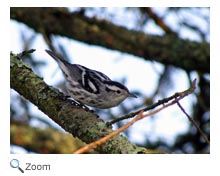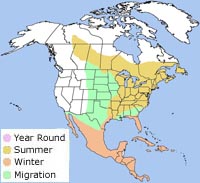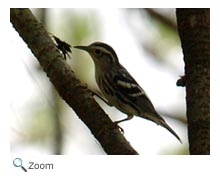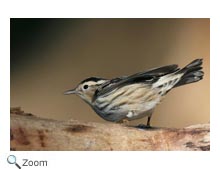Description
 The black and white warbler is small perching bird that is about 5 inches in length. It has black and white stripes that run from the crown of its head to its rump. The male has a black throat, and the female has a white throat.
It had a black bill, legs, and feet. It has a long hind toe and claw that help it climb along tree trunks and branches. The black and white warbler is small perching bird that is about 5 inches in length. It has black and white stripes that run from the crown of its head to its rump. The male has a black throat, and the female has a white throat.
It had a black bill, legs, and feet. It has a long hind toe and claw that help it climb along tree trunks and branches.
Range  The black and white warbler breeds from southern Canada south through the eastern U.S. to Florida. It winters in the Gulf Coast, the Caribbean, Central America, and South America. The black and white warbler is one of the first warblers to return in the spring. The black and white warbler breeds from southern Canada south through the eastern U.S. to Florida. It winters in the Gulf Coast, the Caribbean, Central America, and South America. The black and white warbler is one of the first warblers to return in the spring.
Habitat
The black and white warbler is found in deciduous and mixed forests. |
|
Diet
 The black and white warbler is sometimes called the black-and-white creeper. It creeps around tree trunks and branches in search of insects and spiders hidden under the bark. Unlike the brown creeper, the black and white warbler can creep in any direction! The black and white warbler is sometimes called the black-and-white creeper. It creeps around tree trunks and branches in search of insects and spiders hidden under the bark. Unlike the brown creeper, the black and white warbler can creep in any direction!
Life Cycle  Male warblers arrive at the breeding ground first, usually in April or May, and establish a territory. Males court females by pursuing them, preening, and singing. Once the chase is over, a male will perch next to a female and flutter his wings. Male warblers arrive at the breeding ground first, usually in April or May, and establish a territory. Males court females by pursuing them, preening, and singing. Once the chase is over, a male will perch next to a female and flutter his wings.
The female builds an open cup nest of leaves, pine needles, grass, and bark on the ground, usually at the base of a log or a tree. She lays 4-5 eggs and incubates them for 10-12 days. The male helps protect the nest and brings food to the female while she is nesting. Both parents feed the chicks and defend the nest. The chicks fledge in 8-12 days.
Most females have only one brood year.
Behavior
 The black and white warbler is more aggressive than most warblers and will attack red-breasted nuthatches, black-capped chickadees, and other birds. The black and white warbler is more aggressive than most warblers and will attack red-breasted nuthatches, black-capped chickadees, and other birds. |


 The black and white warbler breeds from southern Canada south through the eastern U.S. to Florida. It winters in the Gulf Coast, the Caribbean, Central America, and South America. The black and white warbler is one of the first warblers to return in the spring.
The black and white warbler breeds from southern Canada south through the eastern U.S. to Florida. It winters in the Gulf Coast, the Caribbean, Central America, and South America. The black and white warbler is one of the first warblers to return in the spring.


